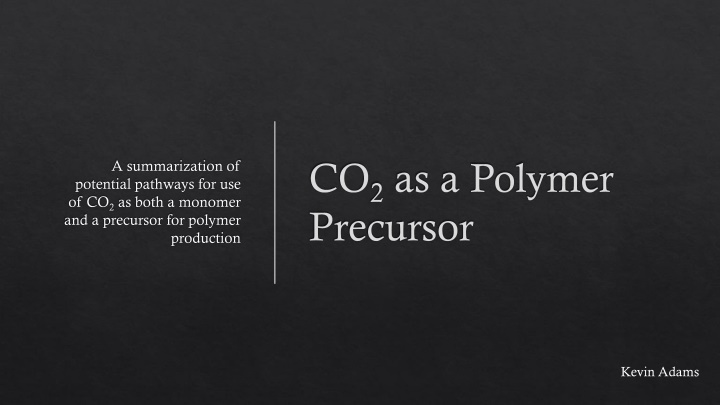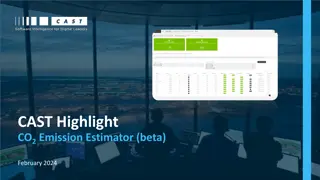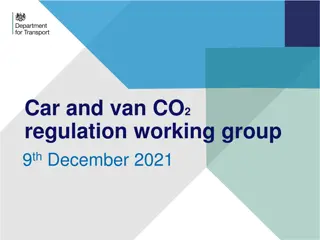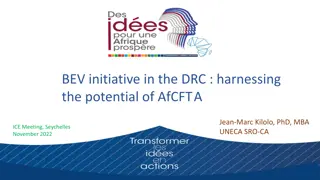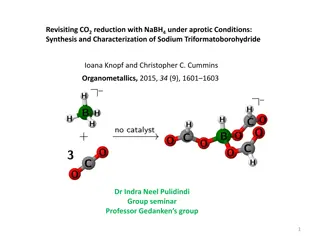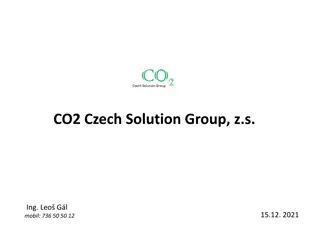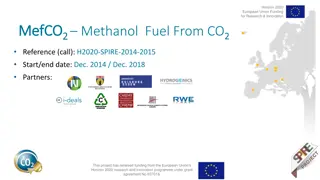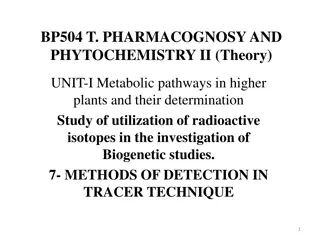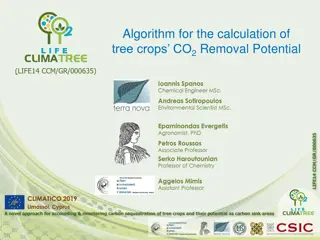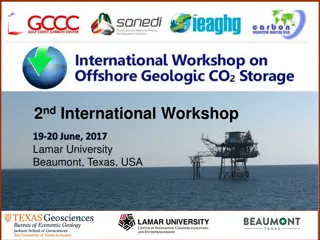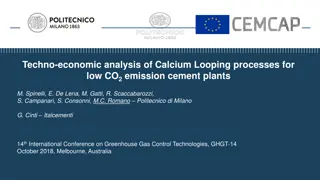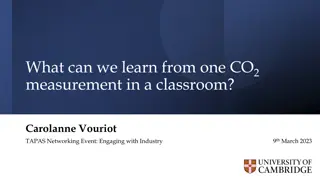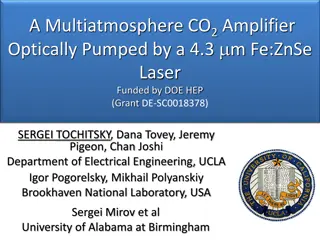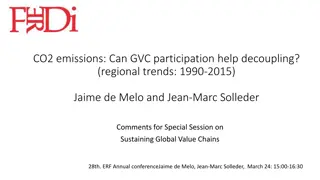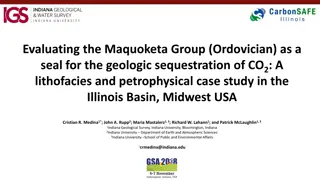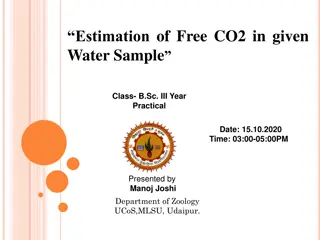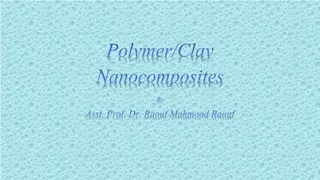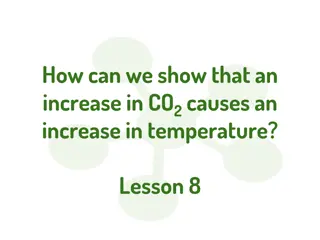Potential Pathways for CO2 as Polymer Precursor
Summary of pathways for utilizing CO2 as both monomer and precursor in polymer production. Focus on decreasing fossil fuel consumption and greenhouse gas emissions. Includes information on epoxide copolymerization, alkyne copolymerization, and olefin copolymerization with CO2. Highlighting the significance of utilizing CO2 as a polymer precursor to lower current levels of fossil fuel consumption.
Download Presentation

Please find below an Image/Link to download the presentation.
The content on the website is provided AS IS for your information and personal use only. It may not be sold, licensed, or shared on other websites without obtaining consent from the author.If you encounter any issues during the download, it is possible that the publisher has removed the file from their server.
You are allowed to download the files provided on this website for personal or commercial use, subject to the condition that they are used lawfully. All files are the property of their respective owners.
The content on the website is provided AS IS for your information and personal use only. It may not be sold, licensed, or shared on other websites without obtaining consent from the author.
E N D
Presentation Transcript
CO2as a Polymer Precursor A summarization of potential pathways for use of CO2as both a monomer and a precursor for polymer production Kevin Adams
CO2 AS A CO2 PRODUCTION FROM FOSSIL FUELS > GREEN CONSUMPTION [2] MOST POLYMERS CURRENTLY DERIVED FROM PETROLEUM BASED FEEDSTOCKS GREENHOUSE GAS Why is this important CO2 AS POLYMER PRECURSOR WILL DECREASE FOSSIL FUEL CONSUMPTION AND POTENTIALLY LOWER CURRENTLY LEVELS
Epoxide copolymerization Alkyne copolymerization CO2as a monomer Olefin copolymerization Diol copolymerization Polymethacrylates Bioderived epoxides
Epoxide Copolymerization First successfully carried out by Inoue et al. in 1969 [7] Can be used to synthesize polycarbonates Safer than older methods involving bisphenol A (BPA) and phosgene Synthesis of poly(cyclohexene carbonate) from cyclohexene oxide [1] Copolymer system Catalyst p (CO2) (bar) T ( C) t (h) References Diethylzinc/water (1:1) catalyst system found to be best with PPO and multiple other simple epoxides CO2 + PPO ZnEt2/H2O 20 50 80 48 [3] Trans product formation CO2 + CHO ZnEt2/H2O ~50 RT 45 [4] Cyclic byproduct by backbiting and high polyether copolymerization CO2 + CHO Zn(II) phenoxides ~55 90 69 [5] CO2 + CHO Zn-fluoroalkyl ~57 60 172 24 [6] Later work by Darensbourg et al. in 1995 expanded on catalyst systems [5] CO2 polymerization parameters with epoxides. PPO is propylene oxide, CHO is 1,2 cyclohexene oxide [1]
Alkyne Copolymerization Work by Song et al. in 2018 [8] Reacting CO2with diyne and alkyl dihalide in presence of Ag2WO4catalyst with Cs2CO3and N,N-dimethylacetamide additives Reacting with a triphenylamine containing diyne lead to formation of telechelic polymer Synthesis of poly(alkatone) from diyne, alkyl dihalide, and CO2 [1] High yield (~95%) under mild conditions (80 C over 12 h) Poly(alkanoate)s can be hydrolyzed under alkaline environment at ambient conditions
Olefin Copolymerization Synthesize poly(caprolactone)/polyester Direct olefin copolymerization with CO2is often limited by the propagation step (endothermic) Often leads to homopolymerization of the olefin [1] Nakano et al. used a lactone intermediate to get around this in 2014 [9] Synthesis of poly(caprolactone) through conceited radical polymerization of lactone synthesized from diene and CO2 [1] Also developed one-pot processes for both co- and ter-polymerization with other dienes Sustainable and scalable process 35-46% yield at 80 C for 3-20 h
Diol Copolymerization Synthesize polycarbonates Kadokawa et al. reacted CO2with p- and m- xylenes to form poly(xylylene carbonate) in 1998 [10] Tamura et al. reacted CO2with 1,4-butylene diol to form poly(tetramethylene carbonate) using a cerium oxide catalyst and 2- cyanopyridine promotor in 2016 [11] Required high pressures (up to 12 MPa = 120 bar) and elevated temperature (160 C) Harder than Epoxide copolymerization, but reactants cheaper (1,4-butanediol is ~30% price of cyclohexene oxide) Synthesis of poly(tetramethylene carbonate) from 1,4-butanediol and CO2
Other methods Polymethacrylates Typically conceited two step mechanism to form polymethacrylates Bioderived Epoxides D-limonene obtained from orange peel Limonene oxide is abundant and structurally similar to cyclohexene oxide Ochiai et al. proposed radical polymerization of glycidyl methacrylate [12] Byrne et al. reported alternating copolymerization under mild conditions (25 C, 100 psi) using CO2 and limonene oxide [13] Works under 1 atm CO2 CO2incorporation controlled by LiBr
Future Using CO2as feedstock for polymers is more sustainable than relying solely on fossil fuel sources Most CO2based polymers are more biodegradable and biocompatible than fossil fuel based alternatives Multiple different potential polymers (not just polycarbonates) Reactions must be made cost effective if they are to be deployed enmass Cost to produce CO2must be less than cost to produce FF polymer Atmospheric Pco2 4 x 10-4bar Will require CO2scrubber or direct to source access to get partial pressure high enough PCO2increasing at ~2.3 x 10-6bar each year, or 2.6 x 1014mol yr-1 Using CO2for polymer production (~1000 mol CO2per mol polymer, ~2 x 108mol polyethylene produced each year) cannot offset yearly CO2increase alone
Sources [1] Mulchandani N., Katiyar V. (2020) Polymers from Carbon Dioxide A Route Towards a Sustainable Future. In: Katiyar V., Kumar A., Mulchandani N. (eds) Advances in Sustainable Polymers. Materials Horizons: From Nature to Nanomaterials. Springer, Singapore dioxide and epoxide with organometallic compounds. Makromol Chem 130:210 220. [8] Song B, He B, Qin A, Tang BZ (2018) Direct polymerization of carbon dioxide, diynes, and alkyl dihalides under mild reaction conditions. Macromolecules 51:42 48. [2] Cui Y, Tang X, Huang X, Chen Y (2003) Synthesis of the star-shaped copolymer of -caprolactone and l-lactide from a cyclotriphosphazene core. Biomacromol 4:1491 1494. [9] Nakano R, Ito S, Nozaki K (2014) Copolymerization of carbon dioxide and butadiene via a lactone intermediate. Nat Chem 6:325. [3] Inoue S, Kobayashi M, Koinuma H, Tsuruta T (1972) Reactivities of some organozinc initiators for copolymerization of carbon dioxide and propylene oxide. Makromol Chem 155:61 73. [10] Kadokawa J, Habu H, Fukamachi S, Karasu M, Tagaya H, Chiba K (1998) Direct polycondensation of carbon dioxide with xylylene glycols: a new method for the synthesis of polycarbonates. Macromol Rapid Commun 19:657 660. [4] Inoue S, Koinuma H, Tsuruta T (1969) Copolymerization of carbon dioxide and epoxide. J Polym Sci B 7:287 292. [11] Tamura M, Ito K, Honda M, Nakagawa Y, Sugimoto H, Tomishige K (2016) Direct Copolymerization of CO2 and Diols. Sci Rep 6:24038. [5] Darensbourg DJ, Holtcamp MW (1995) Catalytic activity of zinc(II) phenoxides which possess readily accessible coordination sites. copolymerization and terpolymerization of epoxides and carbon dioxide. Macromolecules 28:7577 7579. [12] Ochiai B, Hatano Y, Endo T (2008) fixing carbon dioxide concurrently with radical polymerization for utilizing carbon dioxide by low-energy cost. Macromolecules 41:9937 9939. [6] Super M, Beckman EJ (1998) Copolymerization of CO2 and cyclohexene oxide. Macromol Symp 127:89 108. [13] Byrne CM, Allen SD, Lobkovsky EB, Coates GW (2004) Alternating copolymerization of limonene oxide and carbon dioxide. J Am Chem Soc 126:11404 11405. [7] Inoue S, Koinuma H, Tsuruta T (1969) Copolymerization of carbon
